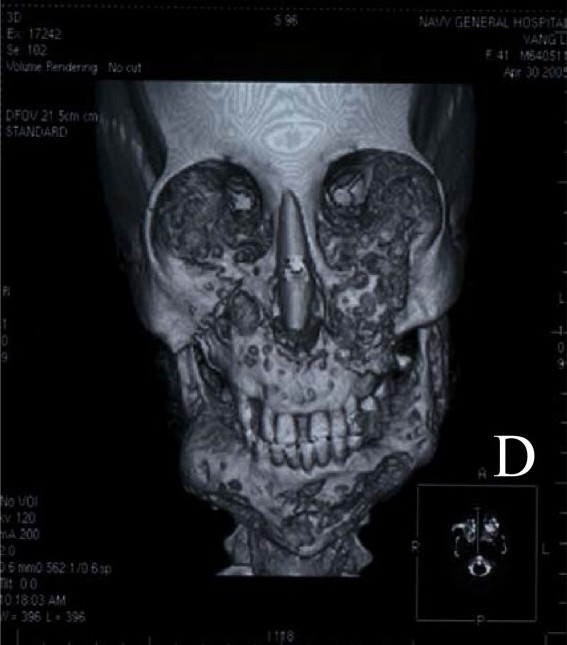Cherubism
Editor-In-Chief: Prab R Tumpati, MD
Obesity, Sleep & Internal medicine
Founder, WikiMD Wellnesspedia &
W8MD medical weight loss NYC and sleep center NYC
| Cherubism | |
|---|---|

| |
| Synonyms | Familial fibrous dysplasia of the jaws |
| Pronounce | N/A |
| Specialty | N/A |
| Symptoms | Painless swelling of the jaw, rounded face |
| Complications | Tooth displacement, vision problems, breathing difficulties |
| Onset | Childhood |
| Duration | Varies, often stabilizes after puberty |
| Types | N/A |
| Causes | Genetic mutation in the SH3BP2 gene |
| Risks | Family history |
| Diagnosis | Clinical examination, radiographic imaging, genetic testing |
| Differential diagnosis | Fibrous dysplasia, giant cell tumor, hyperparathyroidism |
| Prevention | N/A |
| Treatment | Monitoring, surgery if necessary |
| Medication | N/A |
| Prognosis | Generally good, condition often stabilizes |
| Frequency | Rare |
| Deaths | N/A |
Cherubism
Cherubism is a rare genetic disorder that affects the bones of the face, particularly the jawbones. It is characterized by painless, progressive swelling of the cheeks and jaw, giving the affected individuals a cherubic appearance, hence the name.
Etiology[edit | edit source]
Cherubism is caused by mutations in the SH3BP2 gene, which is located on chromosome 4. This gene is responsible for producing a protein involved in the regulation of bone metabolism. The mutation leads to abnormal bone remodeling, resulting in the characteristic facial features of the disorder.
Clinical Features[edit | edit source]
The primary clinical feature of cherubism is bilateral swelling of the cheeks due to the overgrowth of the jawbones. This typically becomes apparent in early childhood, around the age of 2 to 7 years. The condition progresses until puberty, after which it often stabilizes or regresses. Other features may include:
- Dental abnormalities, such as malocclusion, displacement of teeth, and delayed eruption.
- Ocular issues, such as upward displacement of the eyes, giving a "heavenward gaze" appearance.
- In some cases, hearing loss due to involvement of the bones surrounding the ear.
Pathophysiology[edit | edit source]
The pathophysiology of cherubism involves the replacement of normal bone with fibrous tissue and cyst-like structures. This process is driven by the abnormal activity of osteoclasts and osteoblasts, which are cells responsible for bone resorption and formation, respectively.
Diagnosis[edit | edit source]
Diagnosis of cherubism is primarily clinical, based on the characteristic facial appearance and family history. Radiographic imaging of the jaws reveals multilocular radiolucencies, often described as "soap bubble" or "honeycomb" appearances. Genetic testing can confirm the diagnosis by identifying mutations in the SH3BP2 gene.
Management[edit | edit source]
Management of cherubism is largely supportive and symptomatic. Regular dental care is essential to address dental issues. In some cases, surgical intervention may be necessary to correct severe deformities or functional impairments. The condition often stabilizes or improves after puberty, reducing the need for aggressive treatment.
Prognosis[edit | edit source]
The prognosis for individuals with cherubism is generally good. The facial swelling often regresses after puberty, and many individuals experience significant improvement in appearance. However, dental and skeletal issues may persist and require ongoing management.
See also[edit | edit source]
| Genetic disorders relating to deficiencies of transcription factor or coregulators | ||||||||||||||||||||||||||||||||||
|---|---|---|---|---|---|---|---|---|---|---|---|---|---|---|---|---|---|---|---|---|---|---|---|---|---|---|---|---|---|---|---|---|---|---|
|
Search WikiMD
Ad.Tired of being Overweight? Try W8MD's physician weight loss program.
Semaglutide (Ozempic / Wegovy and Tirzepatide (Mounjaro / Zepbound) available.
Advertise on WikiMD
|
WikiMD's Wellness Encyclopedia |
| Let Food Be Thy Medicine Medicine Thy Food - Hippocrates |
Translate this page: - East Asian
中文,
日本,
한국어,
South Asian
हिन्दी,
தமிழ்,
తెలుగు,
Urdu,
ಕನ್ನಡ,
Southeast Asian
Indonesian,
Vietnamese,
Thai,
မြန်မာဘာသာ,
বাংলা
European
español,
Deutsch,
français,
Greek,
português do Brasil,
polski,
română,
русский,
Nederlands,
norsk,
svenska,
suomi,
Italian
Middle Eastern & African
عربى,
Turkish,
Persian,
Hebrew,
Afrikaans,
isiZulu,
Kiswahili,
Other
Bulgarian,
Hungarian,
Czech,
Swedish,
മലയാളം,
मराठी,
ਪੰਜਾਬੀ,
ગુજરાતી,
Portuguese,
Ukrainian
Medical Disclaimer: WikiMD is not a substitute for professional medical advice. The information on WikiMD is provided as an information resource only, may be incorrect, outdated or misleading, and is not to be used or relied on for any diagnostic or treatment purposes. Please consult your health care provider before making any healthcare decisions or for guidance about a specific medical condition. WikiMD expressly disclaims responsibility, and shall have no liability, for any damages, loss, injury, or liability whatsoever suffered as a result of your reliance on the information contained in this site. By visiting this site you agree to the foregoing terms and conditions, which may from time to time be changed or supplemented by WikiMD. If you do not agree to the foregoing terms and conditions, you should not enter or use this site. See full disclaimer.
Credits:Most images are courtesy of Wikimedia commons, and templates, categories Wikipedia, licensed under CC BY SA or similar.
Contributors: Prab R. Tumpati, MD


